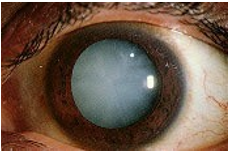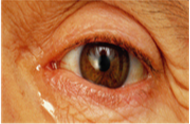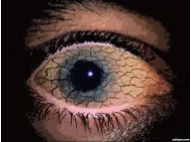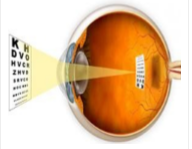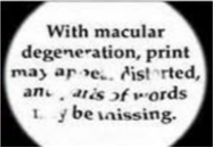Introduction
Having a good eye sight is valuable compared to other things. It is unfortunate if an elder having a poor eye sight, one will stop from enjoying an active lifestyle. For instance;
“Before this, I still able to read at near without holding the reading materials further away from me in order to read clearly”
“Last time, I remember that I still can see clear at far, but recently I noticed that my vision getting blur and cloudy”
“Nowadays, I’m having difficulty to drive confidently at night because I feel glaring from the oncoming car lights”
“Last time, I can drive safely but now I’m afraid that I’m not aware if other vehicles come from the side. I was nearly involved in an accident”
“Sadly, I also bumped into things frequently and hurt myself”
“Recently, I feel uncomfortable, irritate, watery and sandy sensation on my eyes which I’ve never experienced before”
Epidemiology
A research stated that, Malaysian population is estimated to reach up to 33.7 million in 2020 whereby 3.8 million (11.8%) from the total population is elderly. There was a study done in Malaysia on common Age Related Diseases and condition occurred among elderly as described in Table 1.
Table 1: Age Related Diseases And The Explanation
| No | Age Related Diseases / Conditions | Explanations | ||||||||||
| 1 |
Changes in Refractive Error
|
Causes:
|
||||||||||
| 2 |
Cataract
|
Lens become opaque and causing poor vision. In Malaysia, cataract usually occur at age of 60 to 70 years old. Globally, cataract related to aging, contribute up to 48% of the cause of blindness and this is account for about 18 million people in the world. This reversible blindness can be treated by Ophthalmologist with cataract surgery. A matured cataract can lead to secondary glaucoma. It is recommended to have an eye check with an Optometrist or an Ophthalmologist as soon as possible if having cataract. |
||||||||||
| 3 |
Glaucoma
|
Is a chronic, progressive optic neuropathy with increase in Intra Ocular Pressure (IOP) as a risk factor and mostly painless. It is known as silent vision thief. Particularly elder’s age of 60 years and above are at risk. It is highly suggested to have an eye assessment with Optometrist or Ophthalmologist as soon as possible if having visual field defect as in pictures below: Normal
Mild
Chronic
Final Stage
For patient diagnosed with glaucoma, one should comply with medication that being given and followed up appointment as scheduled. |
||||||||||
| 4 |
Watery Eyes
|
Causes:
It is advisable to have an eye assessment with Optometrist or Ophthalmologist. Ophthalmologist able to treat any obstruction or blockage in drainage system. The droopy of lower lid can be treated with plastic surgery by Ophthalmologist. Wearing on sunglasses with the ultra violet (UV) protection can help in reducing one sensitivity to exposure of bright light. |
||||||||||
| 5 |
Dry Eyes
|
Tears production reduced with increasing age. Patient’s eye easily gets tired, irritate and feeling sandy sensation. One way to treat dry eyes is by instillation an Artificial Tears which can easily buy from any pharmacy outlet. It is advisable to get an eye examination with an Ophthalmologist |
||||||||||
| 6 |
Age Related Macular Degeneration (ARMD)
“Black dot” at the central vision
Wording becomes crooked, distorted and wavy
|
ARMD is the main leading vision problem among elderly with age 65 years old and above. ARMD is caused by degeneration of macular (the most sensitive area in the eye) that allows one to see clearly and in details. Symptoms of Wet ARMD
Risk in elderly age 60 years old and above It is recommended to get a comprehensive eye examination with Optometrist and Ophthalmologist. There are 2 types of ARMD: Dry and Wet as listed in Table 2. Table 2: The Differences Between Dry ARMD and Wet ARMD
|
||||||||||
| 7 | Eyelid Problems |
Such as:
Eyelid problems such as Entropion and Dermatochalasis can be treated with cosmetic eye surgery/ oculoplasty. It is suggested to elderly who have eyelid problems to get advice and treatment from Ophthalmologist. Before treatment
After 7 days operation
|
||||||||||
| 8 | Floaters |
Jelly-like structure (Vitreous) inside the eye becomes liquefied with increasing age. This liquified gel clumps together and floating inside the eye thus resulting in floaters and can lead to vision problems. Small number of floaters is considered as normal. If the floaters suddenly increase in number and size, it is a sign of early retinal detachment and need to see Ophthalmologist urgently. |
||||||||||
| 9 | Retinal Detachment |
It is a condition whereby the retinal layer (layer that sensitive to the light) detached from the layer underneath it. Symptoms:
|
Conclusion
Common Age Related Eye Diseases and conditions among elderly as highlighted in Table 1 is preventable and can be treated. Hence, a comprehensive eye screening is important among elderly in order to detect any eye problems earlier.
References
- Alan K. Vision and Eye Problems in aging problems. WebMD: August 01, 2014. Retrieved from http://www.webmd.com/eye-health/vision-problems-aging-adults
- David A. Q. Common causes of vision loss in Elderly Patients. AmFam Physician. 1999 Jul 1:60 (1):99-108 retrieved from http://www.aafp.org/afp/1999/0701/p99.html.
- Radziah binti Abd. Rashid. Kepentingan Saringan Masalah Penglihatan.Portal Myhealth. Oktober 2013
- Singapore National Eye Centre.2013. Retrieved from http://www.snec.com.sg/about/international/menuutama/kondisimataandperawatan/commonproblems/Pages/entropion.aspx
- Gary H. Eight ways to protect your eyesight. Retrieved from http://www.allaboutvision.com/over60/vision-changes.htm
- Hajah farhana Tarmudi. Ramai tak faham masalah glaukoma.h.metro.01/01/2012. Retrieved from http://www2.hmetro.com.my/articles/Ramaitakfahammasalahglaukoma/Article/
- Marilyn H.,Gary H. Ten warning signs of Age-Related Eye Problems. Retrieved from
- http://www.allaboutvision.com/over60/vision-changes.htm
- Marisa H.O. The five most common eye problems in adult. Retrieved from
- http://hubpages.com/hub/The_Five_Most_Common_Eye_Problems_in_Adults
- Panduan untuk penjaga warga emas. Bahagian Pembangunan Kesihatan Keluarga.Kementerian Kesihatan Malaysia. Jun 2008
- Singh. Ophthalmic Problem Among the Elderly in Malaysia. 1997.Med J Malaysia: Volume 52 :213-216
- Rosniza A.R. Kabur Penglihatan. Portal Myhealth. Oktober 2013
- Rosniza A.R. Mata Kering. Portal Myhealth. Jan 2015.
- Shatriah I.Penyakit Katarak di Kalangan Warga Emas. Utusan Malaysia. 27/1/2008
| Last Reviewed | : | 30 October 2017 |
| Writer | : | Nurul Hafizah Binti Mohd Norizan |
| Translator | : | Nurul Hafizah Binti Mohd Norizan |
| Accreditor | : | Hjh. Nor’Aini Binti Hj. Anuar |



